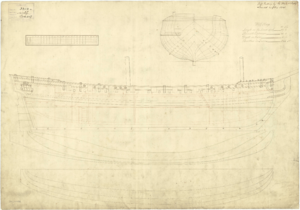HMS Wolf (1742) facts for kids

Drawing showing the body plan, sheer lines with inboard detail, and longitudinal half-breadth for the Wolf, 1741
|
|
Quick facts for kids History |
|
|---|---|
| Name | HMS Wolf |
| Ordered | 21 July 1741 |
| Builder | Thomas West, Deptford |
| Laid down | 31 July 1741 |
| Launched | 27 February 1742 |
| Completed | 15 April 1741 at Deptford Dockyard |
| Commissioned | February 1742 |
| Out of service | 29 October 1745 |
| Reinstated | July 1747 |
| Fate | Wrecked in Dundrum Bay, 31 December 1748 |
| General characteristics | |
| Class and type | 14-gun Wolf-class sloop-of-war |
| Tons burthen | 243 74⁄94 (bm) |
| Length |
|
| Beam | 25 ft 2 in (7.7 m) |
| Draught | 10 ft 6 in (3.2 m) |
| Propulsion | Sails |
| Sail plan | snow-rigged |
| Complement | 110 |
| Armament |
|
HMS Wolf was a cool ship from the Royal Navy, built way back in 1742. She was a special kind of warship called a sloop, which was smaller but fast. Wolf had 14 guns and was designed to hunt down enemy ships, especially privateers, during a war known as the War of Jenkins' Ear. She was the first of three ships in her class, all named after the Wolf.
Contents
Building the Ship
The Wolf was the first of three small, speedy ships. They were built for patrolling the coast and sailing in the Atlantic Ocean. The British Navy called these ships the Wolf class. Her design was similar to older ships, but she was bigger and had more powerful weapons.
A shipbuilder named Thomas West was in charge of building the Wolf. He had experience building other ships for the Navy.
Ship's Size and Features
The Wolf was about 87 feet (26.6 meters) long overall. She was about 25 feet (7.6 meters) wide. She had two masts with square sails, which helped her move quickly. The ship also had two decks, not just one.
When she was first built, Wolf carried 14 cannons that fired four-pound cannonballs. She also had 12 smaller swivel guns. These were half-pounder guns mounted on the deck that could turn all the way around.
How Long it Took to Build
Building the Wolf took about seven months. Her keel, which is like the backbone of the ship, was laid down in July 1741. She was finally launched into the water in February 1742. The ship cost about £1,793 to build, and another £1,653 to get her ready for sea.
Adventures at Sea
The Wolf officially joined the Navy in February 1742. After getting all her equipment ready, she sailed to Svalbard. Her first job was to protect English whaling ships.
Hunting Privateers
After the whaling season, Wolf sailed south. She joined other British ships blocking Spanish ports during the War of Jenkins' Ear. This war was fought between Great Britain and Spain.
Wolf was very good at catching enemy ships.
- On December 11, 1742, she captured a Spanish privateer named Nuestra Señora del Pilar y Animas.
- In March 1743, she caught two more privateers: the San Pedro y Animas on March 5, and the Nuestra Señora de la Esclavitud on March 17.
Later, in 1744, Wolf continued her success. She captured two more Spanish ships: La Notre Dame de Boulogne on June 30, and La Palme on July 30.
Captured and Recaptured
In July 1745, Commander John Hughes took command of the Wolf. The ship was patrolling the English Channel. On October 29, 1745, Wolf met a much larger French privateer with 32 guns. The Wolf was outgunned and lost the battle. Commander Hughes and two other sailors were killed. The French took over the Wolf and renamed her La Loup.
But Wolf's time with the French was short. Four months later, on March 1, 1746, two Royal Navy frigates, HMS Amazon and HMS Grand Turk, caught La Loup. The British ships took her back.
The damaged Wolf was brought to Plymouth. After a year, the Navy bought her back in March 1747. She was then sent to Plymouth Dockyard for repairs. It took five months and cost £1,887 to fix her up. This was even more than her original building cost!
Final Voyage and Wreck
The repaired Wolf was ready for duty again in July 1747. She was sent to fight the French in the War of the Austrian Succession. For the next year, she patrolled the North Sea and the coast of Ireland.
On December 31, 1748, the Wolf was caught in a terrible storm. Strong waves pushed her towards the Irish shore. Even though her crew tried their best, the ship crashed in the bay below Dundrum Castle. The Wolf sank, and sadly, everyone on board was lost.

